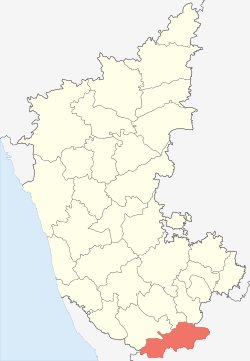Chamarajanagar district
Chamarajanagar is the southernmost district in the state of Karnataka, India. It was carved out of the original larger Mysore District in the year 1998. Chamarajanagar town is the headquarters of this district.[1]
Chamarajanagar District | |
|---|---|
 Valley in the MM Hills | |
 | |
| Coordinates: 12°N 77.3°E | |
| Country | India |
| State | Karnataka |
| Headquarters | Chamarajanagar |
| Taluks | Yelandur, Gundlupet, Chamarajanagar, Kollegal, Hanur |
| Area | |
| • Total | 5,101 km2 (1,970 sq mi) |
| Population (2011) | |
| • Total | 1,020,791 |
| • Density | 200/km2 (500/sq mi) |
| Languages | |
| • Official | Kannada |
| Time zone | UTC+5:30 (IST) |
| PIN | 571 313 |
| Telephone code | 08226 |
| ISO 3166 code | IN-KA |
| Vehicle registration |
|
| Website | chamrajnagar |

It is the third least populous district in Karnataka (out of 30), after Kodagu and Bangalore Rural.[2]
History
Chamarajanagar was earlier known as Sri Arikottara. Chamaraja Wodeyar, the Wodeyar king of Mysuru was born here and hence this place was renamed after him. The Vijaya Parsvanath Basadi, a holy Jain shrine was constructed by Punisadandanayaka, the commander of the Hoysala king Gangaraja in the year 1117 AD.
Geography
Being the southernmost district of Karnataka, Chamarajanagar district borders the state of Tamil Nadu and Kerala. Specifically, it borders Mysore district of Karnataka to the west and north, Mandya and Ramanagara districts of Karnataka to the north-east, Dharmapuri and Krishnagiri districts of Tamil Nadu to the east, Salem and Erode districts of Tamil Nadu to the south-east, Nilgiris district of Tamil Nadu to the south, and to the extreme south-west, there is a very small border with Wayanad district of Kerala.
Most of the district lies in the leeward region of the Nilgiris and consists of mainly semi-arid rain-dependent flatlands along with forested hills.
National Highway 209, which starts from Bengaluru in Karnataka and ends at NH-7 north of Dindigul in Tamil Nadu, passes through the district at Kollegal and ends up at Punajur (or Punjur), in the western ghats near the Tamil Nadu - Karnataka border.
Demographics
According to the 2011 census Chamarajanagar district has a population of 1,020,791,[2] roughly equal to the nation of Cyprus[3] or the US state of Montana.[4] This gives it a ranking of 441st in India (out of a total of 640).[2] The district has a population density of 200 inhabitants per square kilometre (520/sq mi) .[2] Its population growth rate over the decade 2001-2011 was 5.75%.[2] Chamarajanagar has a sex ratio of 989 females for every 1000 males,[2] and a literacy rate of 61.43%. 86.11% of the population speaks Kannada, 4.58% Tamil, 4.42% Urdu and 3.29% Telugu.[2]
The district has a high percentage of Scheduled Castes, with a population of 259,000, making up a quarter of the district's population. Having a large percentage of forest cover the district also has a high population of forest-dwelling tribals, like the Soligas, Yeravas, Jenu Kurubas and Betta Kurubas. These tribals have their own languages and their total population is around 120,000, and make up 12% of the district population.[5] Other communities include Lingayats, Muslims and Vokkaligas.[6]
| Year | Pop. | ±% p.a. |
|---|---|---|
| 1901 | 334,676 | — |
| 1911 | 344,414 | +0.29% |
| 1921 | 328,501 | −0.47% |
| 1931 | 352,485 | +0.71% |
| 1941 | 390,337 | +1.03% |
| 1951 | 449,448 | +1.42% |
| 1961 | 533,759 | +1.73% |
| 1971 | 616,502 | +1.45% |
| 1981 | 768,198 | +2.22% |
| 1991 | 883,365 | +1.41% |
| 2001 | 965,462 | +0.89% |
| 2011 | 1,020,791 | +0.56% |
| source:[7] | ||
Crime
Since much of the southern area of the district is dense forest, it provided good refuge to the notorious bandit Veerappan, responsible for the death of over a hundred policemen. He was shot dead in an encounter with the specially formed Special Task Force (STF) on 18 October 2004, in Dharmapuri district, Tamil Nadu. He had been on the run for over two decades. The presence of illegal quarrying for black stone imposes a great threat to the forests in the region.
Tourist attractions
The main tourist attractions are Sri Chamarajeshwara temple in Chamrajanagar, Biligiriranga Hills, K Gudi, Male Mahadeshwara Hills, Suvarnavati dam, Shivasamudram, Bandipur national park, Gopalaswamy Hills in Gundlupet and so on.
Image gallery
See also
- Chamarajanagar
- Kollegal
- Mamballi
- Yelandur
- Gundlupet
- Male Mahadeshwara Hills
- Biligiriranga Hills
- Bandipur National Park,
- Chinnada Gudi Hundi
- Badana Guppe
- Mariyala-Gangavadi Halt
- Mukkadahalli
- Mysore–Chamarajanagar branch line
- Kellamballi
- Rechamballi
- Kagalvadi
- Irasavadi
- Aluru
- Badanaguppe
- Mariyala
- Kuderu
References
- "Archived copy". Archived from the original on 9 October 2011. Retrieved 12 October 2009.CS1 maint: archived copy as title (link)
- "District Census 2011". Census2011.co.in. 2011. Retrieved 30 September 2011.
- US Directorate of Intelligence. "Country Comparison:Population". Retrieved 1 October 2011.
Cyprus 1,120,489 July 2011 est.
- "2010 Resident Population Data". U. S. Census Bureau. Archived from the original on 19 October 2013. Retrieved 2011-09-30.
Montana 989,415
- "Chamarajanagar District Population Religion - Karnataka, Chamarajanagar Literacy, Sex Ratio - Census India". www.censusindia.co.in. Retrieved 21 April 2020.
- "Lok Sabha Election 2019, Karnataka profile: Congress-JDS, BJP set for epic clash; Belgaum, Bangalore North, Shimoga key seats". Firstpost. Retrieved 21 April 2020.
- Decadal Variation In Population Since 1901
External links
| Wikivoyage has a travel guide for Chamarajanagar (district). |
| Wikimedia Commons has media related to Chamarajanagar district. |